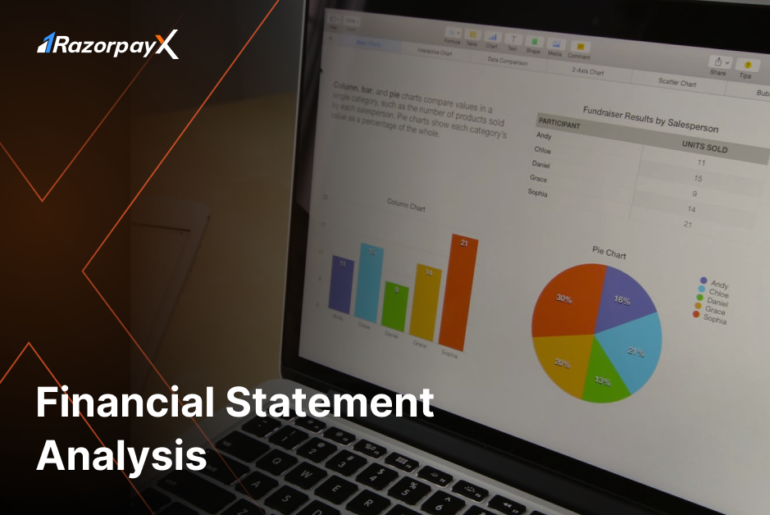For a company, maintaining financial statements like balance sheets, income statements, etc., is quintessential. It analyses them for internal and external stakeholders. This helps in the determination of the financial health or performance of a company to make decisions based on this analysis.
Table of Contents
What is Financial Statements Analysis?
A financial statement analysis or financial statement review refers to the process of evaluating and interpreting a company’s financial statements. These statements are formal records that provide an understanding of the financial performance of a business. The types of statements used in the analysis are the balance sheet, cash flow statement and income statement.
Financial Analysis and Businesses
Successful businesses analyse financial statements extensively to measure performance across all dimensions. Good financial management is key to this success. Today, there are many fintech solutions on the market to help business owners with easier financial management.
RazorpayX is one such business banking platform that imparts hassle-free services to ease modern-day banking. Businesses can open current accounts through RazorpayX to make it easy to record day-to-day financial activities.
How to Analyse Financial Statements?
Step 1: Gather the financial statements
The first step involves a collection of a company’s financial statements, which typically include the balance sheet, income statement, and cash flow statement. These statements provide a snapshot of the company’s financial position, profitability, and cash flow over a specific period.
Step 2: Review the balance sheet
The company’s liabilities, assets, and shareholders’ equity can be assessed by reviewing the balance sheet. Moreover, it includes assessing the liquidity of the company by analysing the current assets or CA (e.g., cash, accounts receivable) and current liabilities or CL (e.g., short-term debt, accounts payable).
Step 3: Analyse the income statement
The income statement shows the company’s revenues, expenses, and net income for an accounting period. Hence, this step includes evaluating the revenue trends, gross profit margin, operating profit margin, and net profit margin. Lastly, compare these figures with industry benchmarks or historical data to assess the company’s profitability.
Step 4: Examine the cash flow statement
The cash flow statement in financial statement analysis outlines the company’s cash inflows and outflows during a given period. In this step, it is essential to look for operating cash flow, investing cash flow, and financing cash flow sections. Moreover, assess the company’s ability to generate cash from its core operations and evaluate its investment and financing activities.
Step 5: Calculate financial ratios
Financial ratios provide insight into various aspects of a company’s performance and can help companies compare it to industry peers. Some important ratios to calculate include profitability ratios, liquidity ratios, and leverage ratios.
Step 6: Conduct trend analysis
Compare financial statement data over multiple periods to identify trends and patterns. Look for consistent growth or decline in key metrics, such as revenue, profit margins, or ratios. This analysis can help understand the company’s financial trajectory.
What are the Different Types of Financial Statements?
- Income Statement
The income statement in financial statement analysis summarises the revenues, expenses, and resulting net income or net loss of a company over a specific period. This usually includes a fiscal quarter or year. It shows the company’s ability to generate profits by detailing the revenues earned and expenses incurred during the stated period.
- Balance Sheet
The balance sheet throws light on the company’s financial position at the end of a fiscal quarter or year. It offers a clear image of a company’s liabilities, assets, and shareholders’ equity. While assets represent what the company owns, liabilities represent what it owes. Contradictorily, shareholders’ equity represents the owners’ residual interest in the assets of the company after deducting liabilities.
- Cash Flow Statement
The cash flow statement provides information about the inflows and outflows of funds of a company during a financial year. It categorises the cash flows into three main sections:
- Operating activities (cash generated from core business operations),
- Investing activities (cash used for asset investing),
- Financing activities (cash used for financing the company’s operations).
These financial statements are usually prepared following accounting principles and standards, such as GAAP or Generally Accepted Accounting Principles or IFRS or International Financial Reporting Standards. It depends on the jurisdiction and reporting requirements.
What are the Benefits of Financial Statement Analysis?
- Performance Evaluation
Financial statement analysis helps evaluate a company’s historical and current financial performance. By analysing financial ratios, trends, and other indicators, stakeholders can assess profitability, liquidity, efficiency, and other aspects of the company’s operations. This analysis enables them to compare the company’s performance with industry benchmarks.
- Decision Making
This analysis aids in making informed business decisions. By examining the financial statements, stakeholders can evaluate the financial viability of potential investments, acquisitions, or partnerships. It helps assess the risks and returns associated with these decisions and assists in determining the allocation of resources for future growth and profitability.
- Financial Health Assessment
Financial statement analysis provides insights into a company’s financial health and stability. It helps stakeholders assess the company’s ability to meet its financial obligations, such as debt repayments and dividend payments.
What are the Methods of Financial Statements Analysis?
- Horizontal Analysis
Horizontal analysis compares financial statement data over multiple periods to identify trends and changes in key financial metrics. It involves calculating the percentage change between periods for items such as revenue, expenses, and net income. Horizontal analysis helps identify growth rates, patterns, and areas of improvement or concern over time.
- Vertical Analysis
Vertical analysis is a process of determining financial statement items in the percentage of a base figure. Typically, the base figure for the income statement is total revenue, while for the balance sheet, it is total assets or total liabilities and shareholders’ equity. This helps assess the composition and relative significance of different components within the financial statements.
- Ratio Analysis
Ratio analysis in financial statement analysis involves calculating and interpreting various financial ratios derived from the data in financial statements. Financial ratios provide insights into a company’s liquidity, profitability, solvency, efficiency, and other aspects of its financial performance. Examples of commonly used financial ratios include the current ratio, debt-to-equity ratio, gross profit margin, return on assets, and return on equity.
How does RazorpayX Help Businesses Taking Better Financial Decisions?
RazorpayX, a stellar business banking suite is designed to offer a diverse range of assistance to business owners. As modern business requirements call for modern solutions, facilities like the current account powered by RazorpayX ensure complete automation in preparing financial statements. With access to a smart dashboard, where one can understand the inflows and outflows of funds, taking financial decisions has become hassle-free.
In addition to this, the forex funding facility integrated with RazorpayX helps entrepreneurs meet their capital requirements. Not to mention, the team dedicated to assisting this service also imparts necessary guidance about RBI rules and regulations related to forex lending and other compliances.
Read more:
FAQs
What is the purpose of analysing financial statements every accounting year?
Financial statements analysis aims to assess the financial health, profitability, liquidity, and stability of a company. By analysing these statements, investors, analysts, and stakeholders can gain insights into the company's financial condition, make informed decisions, and evaluate its performance relative to industry peers.
How can financial statement analysis determine a company’s financial performance?
Financial statement analysis is directly related to the assessment of the financial performance of a company. This report of financial performance contains ratios, looking at its numbers an analyst can determine how efficiently the company can generate profits and increase shareholder value.
What is an example of financial statement analysis?
Generally, analysts take note of different ratios and use them on the income statement of the company to understand its profit-earning capacity. For example, the analyst takes into consideration the gross profit margin, which is determined by subtracting the cost of goods sold from revenues. An increase in this indicator means that the financial performance of the company is positive.
What is DuPont Analysis?
DuPont Analysis is an important tool for financial statement analysis as it determines a company's strengths and weaknesses by separating different components of the Return on Equity (ROE) metrics. The formula followed for DuPont analysis is: Return on Equity (ROE)= (Net Income / Revenue) * (Revenue/Average Total Assets) * (Average Total Assets /Average Total Equity)





